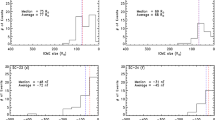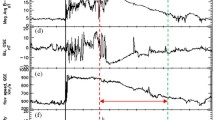Abstract
Interplanetary coronal mass ejections (ICMEs) are believed to be the most common and important drivers of the strongest geomagnetic storms. In this work, the geoeffective characteristics of the ICMEs occurred during the last solar cycles 23 and 24 (years 1996–2017) have been studied in detail. The maximum velocity \(V\)max, either of the ICME’s Sheath region or of the ICME itself, the mean velocity of the ICME, the minimum value of the southward component of the Interplanetary magnetic field Bs and the \(y\)-component of the solar wind convective electric field \(E= -V \times B\) observed at L1 point during the pass of the ICME, were used. It was found that, in accordance to past similar studies, the most dominant characteristic of ICMEs in the generation of geomagnetic storms is the Bs component along with the Ey parameter, while the maximum velocity seems to be of less importance. Nevertheless the maximum speed is an good forecasting factor due to the fact that it is much easier to estimate the velocity of an ICME-structure many hours before it arrives at Earth compared with the observations of Bs and Ey that can only be done, for the time being, at the L1 point. That means we can use the velocity of ICME-structure to forecast the possible generation and magnitude of the geomagnetic storms. From a comparison of the ICME-generated geomagnetic storms with the total number of geomagnetic storms generated during the last two solar cycles, it seems that approximately half of the ICMEs (49% for Dst index and 53% for Kp index) produced geomagnetic storms during the solar cycles 23 and 24. Moreover the velocities of ICMEs are more in accordance with the rising and maximum phases of solar cycles 23 and 24 than the geomagnetic activity (storms) are, as well as during the first stages of the declining phases of these cycles, especially during solar cycle 23.












Similar content being viewed by others
References
Borovsky, E.J., Shprits, Y.: Is the Dst index sufficient to define all geospace storms? J. Geophys. Res. 122, 11543 (2017). https://doi.org/10.1002/2017JA024679
Chi, Y., Shen, S., Wang, Y., Xu, M., Ye, P., Wang, S.: Statistical study of the interplanetary coronal mass ejections from 1995 to 2015. Sol. Phys. 291, 2419 (2016). https://doi.org/10.1007/s11207-016-0971-5
Daglis, I.A., Kozyra, J.U., Kamide, Y., Vassiliadis, D., Sharma, A.S., Liemohn, M.W., Gonozalez, W.D., Tsurutani, B.T., Lu, G.: Intense space storms: critical issues and open disputes. J. Geophys. Res. 108, 1208 (2003). https://doi.org/10.1029/2002JA009722
Dungey, J.R.: Interplanetary magnetic field and auroral zones. Phys. Rev. Lett. 6, 47 (1961). https://doi.org/10.1103/PhysRevLett.6.47
Echer, E., Gonzalez, W.D., Tsurutani, B.T., Gonzalez, A.L.C.: Interplanetary conditions causing intense geomagnetic storms (\(\mathrm{Dst} \leq -100~\mbox{nT}\)) during solar cycle 23 (1996–2006). J. Geophys. Res. 113, A05221 (2008). https://doi.org/10.1029/2007JA012744
Echer, E., Korth, A., Bolzan, M.J.A., Friedel, R.H.W.: Global geomagnetic responses to the IMF \(B _{z}\) fluctuations during the September/October 2003 high speed stream intervals. Ann. Geophys. 35, 853 (2017). https://doi.org/10.5194/angeo-35-853-2017
Feynman, J., Gabriel, S.B.: On space weather consequences and predictions. J. Geophys. Res. 105, 10543 (2000). https://doi.org/10.1029/1999JA000141
Galata, E., Ioannidou, S., Papailiou, M., Mavromichalaki, H., Paravolidakis, K., Kouremeti, M., Rentifis, L., Simantirakis, E., Trachanas, K.: Astrophys. Space Sci. 138, 362 (2017). https://doi.org/10.1007/s10509-017-3118-8
Ganushkina, N.Yu., Liemohn, M.W., Dubyagin, S.: Current systems in the Earth’s magnetosphere. Rev. Geophys. 56, 309 (2018). https://doi.org/10.1002/2017RG000590
Gerontidou, M., Mavromichalaki, H., Daglis, T.: High-speed solar wind streams and geomagnetic storms during solar cycle 24. Sol. Phys. 131, 293 (2018). https://doi.org/10.1007/s11207-018-1348-8
Gonzalez, W.D., Joselyn, J.A., Kamide, Y., Kroehl, H.W., Rostoker, G., Tsurutani, B.T., Vasyliunas, V.M.: What is a geomagnetic storm? J. Geophys. Res. 99, 5771 (1994). https://doi.org/10.1029/93JA02867
Gonzalez, W.D., Tsurutani, B.T., Gonzalez, A.L.: Interplanetary origin of geomagnetic storms. Space Sci. Rev. 88, 529 (1999). https://doi.org/10.1023/A:1005160129098
Gonzalez, W.D., Echer, E., Tsurutani, B.T., Gonzalez, A.L.: Interplanetary origin of intense, superintense and extreme geomagnetic storms. Space Sci. Rev. 158, 69 (2011). https://doi.org/10.1007/s11214-010-9715-2
Gopalswamy, N., Akiyama, S., Yashiro, S., Xie, H., Mäkelä, P., Michalek, G.: Anomalous expansion of coronal mass ejections during solar cycle 24 and its space weather implications. Geophys. Res. Lett. 41, 2673 (2014). https://doi.org/10.1002/2014GL059858
Gosling, J.T., McComas, D.J., Philips, J.L., Bame, S.J.: Geomagnetic activity associated with Earth passage of interplanetary shock disturbances and coronal mass ejections. J. Geophys. Res. 96, 7831 (1991). https://doi.org/10.1029/91JA00316
Huttunen, K.E.J., Schwenn, R., Bothmer, V., Koskinen, H.E.: Properties and geoeffectiveness of magnetic clouds in the rising, maximum and early declining phases of solar cycle 23. Ann. Geophys. 23, 625 (2005). https://doi.org/10.5194/angeo-23-625-2005
Ji, E.-Y., Moon, Y.-J., Kim, K.-H., Lee, D.-H.: Statistical comparison of interplanetary conditions causing intense geomagnetic storms (\(\mathrm{Dst} \leq -100~\mbox{nT}\)). J. Geophys. Res. 115, A10232 (2010). https://doi.org/10.1029/2009JA015112
Lakhina, G.S., Tsurutani, B.T.: Geomagnetic storms: historical perspective to modern view. Geosci. Lett. 3, 5 (2016). https://doi.org/10.1186/s40562-016-0037-4
Loewe, C.A., Prölss, G.W.: Classification and mean behavior of magnetic storms. J. Geophys. Res. 102, 14209 (1997). https://doi.org/10.1029/96JA04020
Mavromichalaki, H., Vassilaki, A.: Fast plasma streams recorded near the Earth during 1985–1996. Sol. Phys. 183, 181 (1998). https://doi.org/10.1023/A:1005004328071
Mayaud, P.N.: Derivation, meaning and use of geomagnetic indices. In: Geophys. Monogr. Ser., vol. 22. AGU, Washington (1980)
Menvielle, M., Berthelier, A.: The \(K\)-derived planetary indices: description and availability. Rev. Geophys. 29, 415 (1991). https://doi.org/10.1029/91RG00994
Mustajab, F., Badruddin: Geoeffectiveness of the interplanetary manifestations of coronal mass ejections and solar-wind stream-stream interactions. Astrophys. Space Sci. 331, 91 (2011). https://doi.org/10.1007/s10509-010-0428-5
O’Brien, T.P., McPherron, R.L.: An empirical space analysis of ring current dynamics: solar wind control of injection and decay. J. Geophys. Res. 105, 7707 (2000). https://doi.org/10.1029/1998JA000437
Owens, M.J., Cargill, P.J., Pagel, C., Siscoe, G.L., Crooker, N.U.: Characteristic magnetic field and speed properties of interplanetary coronal mass ejections and their sheath regions. J. Geophys. Res. 110, A01105 (2005). https://doi.org/10.1029/2004JA010814
Paouris, E., Mavromichalaki, H.: Interplanetary coronal mass ejections resulting from Earth-directed CMEs using SOHO and ACE combined data during solar cycle 23. Sol. Phys. 292, 24 (2017a). https://doi.org/10.1007/s11207-017-1050-2
Paouris, E., Mavromichalaki, H.: Effective acceleration model for the arrival time of interplanetary shocks driven by coronal mass ejections. Sol. Phys. 292, 11 (2017b). https://doi.org/10.1007/s11207-017-1212-2
Rama, R.P.V.S., Gopi, K.S., Vara, P.J., Prasad, S.N.V.S., Prasad, D.S.V.V.D., Niranjan, K.: Geomagnetic storms effects on GPS based navigation. Ann. Geophys. 27, 2101 (2009). https://doi.org/10.5194/angeo-27-2101-2009
Richardson, I.G., Cane, H.V.: Near-Earth interplanetary coronal mass ejections during solar cycle 23 (1996–2009): catalogue and summary of properties. Sol. Phys. 264, 189 (2010). https://doi.org/10.1007/s11207-010-9568-6
Richardson, I.G., Cane, H.V.: Geoeffectiveness (Dst and Kp) of interplanetary coronal mass ejections during 1995–2009 and implications for storm forecasting. Space Weather 9, S07005 (2011). https://doi.org/10.1029/2011SW000670
Richardson, I.G., Cliver, E.W., Cane, H.V.: Sources of geomagnetic storms for solar minimum and maximum conditions during 1972–2000. Geophys. Res. Lett. 28, 2569 (2001). https://doi.org/10.1029/2001GL013052
Riley, P., Love, J.J.: Extreme geomagnetic storms: probabilistic forecasts and their uncertainties. Space Weather 15, 53–64 (2017). https://doi.org/10.1002/2016SW001470
Riley, P., Ben-Num, M., Linker, J.A.: Forecasting the properties of the solar wind using simple pattern recognition. Space Weather 15, 526–540 (2017). https://doi.org/10.1002/2016SW001589
Thomson, A.W.P., McKay, A.J., Clarke, E., Reay, S.J.: Surface electric fields and geomagnetically induced currents in the Scottish Power grid during the 30 October 2003 geomagnetic storm. Space Weather 3, S11002 (2005). https://doi.org/10.1029/2005SW000156
Tsurutani, B.T., Gonzalez, W.D.: The interplanetary causes of magnetic storms: a review. In: Magnetic Storms. Geophys. Monogr. Ser., vol. 98, p. 77 (1997). https://doi.org/10.1029/GM098p0077
Tsurutani, B.T., Gonzalez, W.D., Tang, F., Akasofu, S.I., Smith, E.J.: Origin of interplanetary southward magnetic fields responsible for major magnetic storms near solar maximum (1978–1979). J. Geophys. Res. 93, 8519 (1988). https://doi.org/10.1029/JA093iA08p08519
Welling, D.T.: The long-term effects of space weather on satellite operations. Ann. Geophys. 28, 1361 (2010). https://doi.org/10.5194/angeo-28-1361-2010
Zhang, G., Burlaga, L.F.: Magnetic clouds, geomagnetic disturbances, and cosmic ray decreases. J. Geophys. Res. 93, 2511 (1988). https://doi.org/10.1029/JA093iA04p02511
Zhang, J., Richardson, I.G., Webb, D.F., Gopalswamy, N., Huttunen, E., Kasper, J.C., Nitta, N.V., Poomvises, W., Thompson, B.J., Wu, C.-C., Yashiro, S., Zhukov, A.N.: Solar and interplanetary sources of major geomagnetic storms (\(\mathrm{Dst} \leq -100\) nT) in 1996–2005. J. Geophys. Res. 112, A10102 (2007). https://doi.org/10.1029/2007JA012321
Acknowledgements
The authors appreciate the OMNI Database and the WDC, Kyoto Database for their contribution in data for this work. The OMNI data (Kp and plasma data) were obtained from GSFC/SPDF OMNIWeb and the Dst data were obtained from the WDC for Geomagnetism. We also acknowledge SILSO Database for its contribution with SSN data. Finally, the authors are grateful to I.G. Richardson and H.V. Cane for their contribution in the ICMEs data with their comprehensive catalogue and studies.
Author information
Authors and Affiliations
Corresponding author
Ethics declarations
Conflict of Interest
The authors indicate that there is no conflict of interest.
Additional information
Publisher’s Note
Springer Nature remains neutral with regard to jurisdictional claims in published maps and institutional affiliations.
Rights and permissions
About this article
Cite this article
Alexakis, P., Mavromichalaki, H. Statistical analysis of interplanetary coronal mass ejections and their geoeffectiveness during the solar cycles 23 and 24. Astrophys Space Sci 364, 187 (2019). https://doi.org/10.1007/s10509-019-3677-y
Received:
Accepted:
Published:
DOI: https://doi.org/10.1007/s10509-019-3677-y




